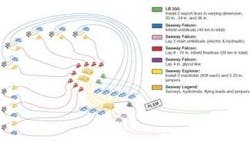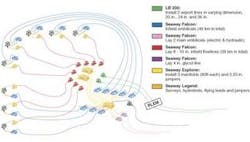BG faces risk in West Delta Deep development
If one were looking for one statement that would describe British Gas and its Burullus partners’ deepwater gas subsea-to-beach development in the Egyptian Mediterranean, it would be this: hardly ever has a company with relatively little experience with a technology taken such a big risk on a very important development.
BG’s management did not fully appreciate the technical challenges that its project team faced in developing its West Delta Deep Marine (WDDM) concession and its 34 bcm in reserves using subsea technology. Here was a license group with little experience using subsea technology planning to install up to 54 subsea wells over a decade in waters to 1,000 m and tying it all back directly to shore.
This does not seem particularly relevant now, as the Burullus consortium - BG operates with 25% for Petronas (25%) and Egyptian General Petroleum Corp. (50%) - looks forward to bringing the second phase of WDDM - the development of the Siena-Simian-Sapphire fields - into production in 1Q 2005. Existing production from the Scarab/Saffron fields, which started two years ago, has been stable at 16 MMcm/d, although it could be pushed to 21 MMcm/d if required. When the three-center complex is fully up and running, production will plateau at 59 MMcm/d, which will continue for 25 years.
BG won the WDDM concession in 1995 and made the first discovery there two years later. Since then, 16 exploration and appraisal wells have identified nine separate S fields. In addition to the five already mentioned, there are Serpent, Saurus, Sequoia, and Solar.
When BG first looked at concepts for developing these prospects, which are 90 km to 120 km from shore in waters ranging from 650 m to beyond 1,100 m, it had two issues in mind. There was a considerable amount of water that BG would produce with the gas presenting a major flow assurance issue and, as the total reserves in the license were yet to be defined, the company wanted a limited initial capital investment.
These concerns mitigated against a deepwater production facility - BG considered both an FPSO and a compliant tower - due to the high upfront cost and the potential problems with slugging in the risers. BG also looked at subsea production to a shallow-water platform, but it offered few advantages and one major disadvantage - this is a very busy waterway for an offshore platform.
So subsea-to-beach it would be.
Having chosen to develop the complex with a subsea solution, BG brought in Intec as its engineering adviser for the offshore portion of the development and gave it a field proven technology. The key technology element - the subsea control system - could only come from one supplier, Kværner Oilfield Products, who had supplied similar equipment to Shell for its Mensa development in the Gulf of Mexico. In fact, the scheme for Scarab/Saffron, Phase 1 of WDDM, would best be described as a GoM scheme, compared with a North Sea solution.
For example, the field has separate hydraulic and electrical/communications umbilicals, as is common in the GoM. Although the hydraulic umbilical is of the steel-tubed variety Statoil first used in the Norwegian sector of the North Sea, it is armored. The latter protects the umbilical from anchor dragging in the near-shore area.
The general scheme for Phase 1 was a pair of pipelines - 36 in. and 24 in. - from shore to a pipeline end manifold (PLEM) 70 km offshore. This provided a tie-in point for the later phases and to some extent, ensured some local content in the project. Egyptian contractor PetroJet was responsible for pipe coating and inshore pipe laying. From the PLEM, separate 20-in. infield flowlines run an additional 30 km to the Scarab and Saffron manifolds, each fed by four wells. The gas from Phase 1 has been fed into the local Egyptian national grid.
With BG looking for 97% availability in the system, the control system reliability was important.
To ensure that production could not be shut down indefinitely, BG insisted on a backup system. The most obvious choice would have been two pairs of umbilicals, but BG could not see the value in a backup that was as vulnerable to the same type of failures as the main system.
The result was the inclusion of a backup integrated control system (BUICS). This is a satellite communications system linked to an infield support vessel, which uses a dynamic umbilical to connect with the Umbilical Termination Assembly. This is not a cheap solution. It requires not only a full backup control system, but also a permanently deployed field support vessel. But it does provide security of production.
The field support vessel Fugro provided under long-term contract proved to be a neutral cost item in the ongoing field development program. It has provided general support and supply services to drilling units, which have been working continuously on the field during the ongoing development drilling and exploration program.
While the control system reliability was the key technical issue, there were others that might not seem obvious and that defied the field proven mantra for the project. The system design required a 20-in. vertical pipeline connector - a beast, which did not exist in the marketplace. Cameron, which provided the subsea trees for Phase 1 scaled up a smaller version, but this new unit required significant testing. Similarly large diameter (20-in.) valves rated for the 1,000 m location are also not off-the-shelf items.
The contracting strategy for Phase 1 had the project team overseeing a number of contractors - including installation contractor Stolt Offshore - which proved to be a headache for a relatively small team. Managing changes and interfaces with different suppliers is always the most difficult part of any project.
When Burullus went out to bid for Phase 2 - Sienna, Simian, and Sapphire - it decided to take the engineering, procurement, construction, and installation turnkey approach and pay a main contractor to worry about delivery of equipment and the vagaries of the weather. The contract went to Technip. BG was less worried about the control system and allowed this element to be included in Technip’s scope. The job went to ABB Offshore Systems, now Vetco Gray Controls. Cameron again supplied the trees.
Another change in Phase 2 was the decision to install a shallow-water platform near to the site of the Phase 1 PLEM. There were a number of elements that suggested this solution. With Phase 2 extending the tieback distance to 120 km, the installation of the platform put the master control station within 50 km of the manifolds. Also, locating the high-pressure hydraulic unit (HPU) on the platform reduced the umbilical link with the shore terminal to power and communications. It also provided a local content element for Phase 2, which would have had none without it.
Phase 2 has two phases. Initially, it will have manifolds on Simian and Sienna, with six wells and two wells, respectively. A 26-in. pipeline links them in series and then back to the PLEM. Sapphire, with another eight wells, will be added later. This will bring the early development phase to 24 wells, but it is expected that another 30 wells could be drilled in the entire 25-year life of the complex.
While BG/Burullus can look back on a pair of successful projects, they have not been without incident. The field came onstream as scheduled, but then immediately shut down because of control system glitches. The smaller of the pipelines from the PLEM to shore developed a buckle and underwent repair. Also, during the delivery of the BUICS system, its operations container was dropped, destroying most of the system, which then had to be rebuilt.
BG will have had a lifetime’s worth of subsea experience by the time the company drills all of the WDDM subsea wells and they start production. Even with what it has done to date, BG has had the confidence to develop the Atlantic/Cromarty fields back in UK waters as a subsea-to-beach project. It is a more modest development with a smaller hydrocarbons base, which required more economic compromises, but BG’s understanding of flow assurance issues has allowed it to install a multiphase pipeline 80 km to shore. That is what is called the learning curve.

